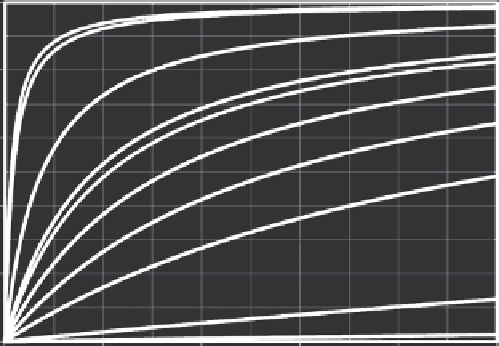Environmental Engineering Reference
In-Depth Information
100
Toxaphene
Naphthalene
80
PCE
1,1,1-TCA
60
TCE
Benzene
40
cis
-DCE
Vinyl chloride
20
Tetrahydrofuran
1,4-Dioxane
0
0.000
0.002
0.004
Organic carbon fraction (f
oc
)
0.006
0.008
0.010
FIGURE 8.4
Sorbed percent of select VOCs and its relation to increasing amounts of organic carbon within geologic media.
(Adapted from Payne, F.C. et al.,
Remediation Hydraulics
, CRC Press, Boca Raton, FL, 2008. With permission.)
• Chemical stability and persistence. Stable compounds have more time to migrate
and may migrate further if conditions are favorable before they are degraded,
transformed, or destroyed.
• Sorptive properties. Sorptive processes include adsorption and absorption. The
lower the sorptive properties, the higher the migration potential. This relationship
is shown in Figure 8.4, which graphs the percent sorbed (nonaqueous) of select
volatile organic compounds (VOCs) in relation to organic carbon content within
the subsurface. For this relationship to exist, the number of sorption sites within
the geological materials has not been exceeded (Payne et al. 2008).
Specific geologic factors affecting migration of contaminants in soil include (Rogers 1996;
USGS 2006a; Rogers et al. 2007):
• Composition. As noted in Chapters 2 and 3, soil type has a significant influence
on the migration of contaminants. In general, coarse-grained soils, such as sand
and gravel, do not impede the migration of contaminants nearly as much as soils
composed of clay.
• Porosity and permeability. Direct evidence of migration potential is hydraulic con-
ductivity. As described in Chapter 3, soils composed of sand and gravel have a
hydraulic conductivity generally 100 to 1000s of times higher than soils composed
of clay. Although soils or sediments composed of clay may have a high relative
porosity, they are usually not as permeable because the porosity is generally not
interconnected, or the pore spaces are simply too small to allow the flow of water.
In some cases, however, as demonstrated in Chapter 3, secondary porosity such
as root fragments and vertical fractures can make a seemingly impervious clay
deposit much more permeable than expected.
• Organic carbon content. As just discussed, an increased total organic content in
soil may impede the migration of certain types of contaminants as long as the

Search WWH ::

Custom Search